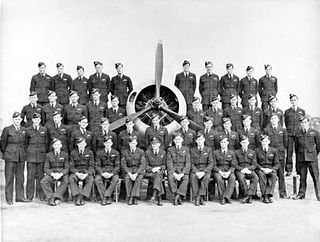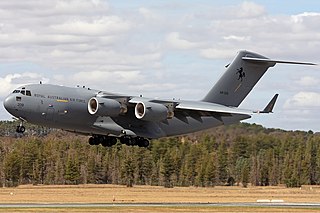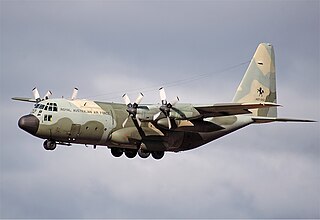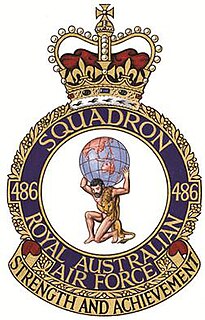
The Royal Australian Air Force (RAAF) is the principal air and space force of Australia, a part of the Australian Defence Force (ADF) along with the Royal Australian Navy and the Australian Army. Constitutionally, the Governor-General of Australia, is the de jure Commander-in-Chief of the Australian Defence Force. The Royal Australian Air Force is commanded by the Chief of Air Force (CAF), who is subordinate to the Chief of the Defence Force (CDF). The CAF is also directly responsible to the Minister of Defence, with the Department of Defence administering the ADF and the Air Force.
The Australian Antarctic Division (AAD) is a division of the Department of Agriculture, Water and the Environment. The Division undertakes science programs and research projects to contribute to an understanding of Antarctica and the Southern Ocean. It conducts and supports collaborative research programs with other Australian and international organisations, such as the Bureau of Meteorology and Geoscience Australia, as well as administering and maintaining a presence in Australian Antarctic and sub-Antarctic territories.

The Avro Type 694 Lincoln is a British four-engined heavy bomber, which first flew on 9 June 1944. Developed from the Avro Lancaster, the first Lincoln variants were initially known as the Lancaster IV and V; these were renamed Lincoln I and II. It was the last piston-engined bomber operated by the Royal Air Force (RAF).

RAAF Base Richmond is a Royal Australian Air Force (RAAF) military air base located within the City of Hawkesbury, approximately 50 kilometres (31 mi) North-West of the Sydney Central Business District in New South Wales, Australia. Situated between the towns of Windsor and Richmond, the base is the oldest base in New South Wales and the second oldest in Australia. The base is home to the transport headquarters RAAF Air Lift Group, and its major operational formations, Nos. 84 and 86 Wings. The main aircraft type operated at the base is the Lockheed C-130 Hercules. Richmond is a regular venue for air shows and had at times been mooted as a site for Sydney's proposed second international airport.

No. 36 Squadron is a Royal Australian Air Force (RAAF) strategic transport squadron. It operates Boeing C-17 Globemaster III heavy airlifters from RAAF Base Amberley, Queensland. The squadron has seen active service flying transport aircraft during World War II, the Korean War, the Indonesia–Malaysia Konfrontasi, the Vietnam War, and the wars in Afghanistan and Iraq. It has also supported Australian humanitarian and peacekeeping operations around the world, including Somalia, Cambodia, East Timor and Indonesia.

No. 37 Squadron is a Royal Australian Air Force (RAAF) medium tactical airlift squadron. It operates Lockheed Martin C-130J Hercules aircraft from RAAF Base Richmond, New South Wales. The squadron has seen active service flying transport aircraft during World War II, the Vietnam War, the wars in Afghanistan and Iraq, and the military intervention against ISIL. It has also supported Australian humanitarian and peacekeeping operations around the world, including in Somalia, East Timor, Bali, Papua New Guinea, and the Philippines.
No. 34 Squadron is a Royal Australian Air Force (RAAF) VIP transport squadron. It operates Boeing 737 Business Jets and Dassault Falcon 7Xs from Defence Establishment Fairbairn in Canberra. The squadron was formed in February 1942 for standard transport duties during World War II, initially flying de Havilland DH.84 Dragons in Northern Australia. In 1943 it re-equipped with Douglas C-47 Dakotas, which it operated in New Guinea and the Dutch East Indies prior to disbanding in June 1946.

No. 38 Squadron was a Royal Australian Air Force (RAAF) transport and training unit active between 1943 and 2018. It was formed on 15 September 1943 and saw service during World War II transporting supplies and personnel between Australia and the combat zones in New Guinea and Borneo, using Douglas Dakota aircraft. Following the war, the squadron conducted regular courier flights between Australia and Japan in 1947 and 1948. No. 38 Squadron was deployed to Singapore from 1950 to 1952, supplying Commonwealth forces engaged in the Malayan Emergency and undertaking courier flights across Asia. In 1954 it became responsible for training RAAF personnel to operate Dakotas.

No. 82 Wing is the strike and reconnaissance wing of the Royal Australian Air Force (RAAF). It is headquartered at RAAF Base Amberley, Queensland. Coming under the control of Air Combat Group, the wing operates F/A-18F Super Hornet multirole fighters and Pilatus PC-21 forward air control aircraft. Its units include Nos. 1 and 6 Squadrons, operating the Super Hornet, and No. 4 Squadron, operating the PC-21.

Central Flying School (CFS) is a Royal Australian Air Force (RAAF) training unit, located at RAAF Base East Sale, Victoria. It operates the Pilatus PC-21 turboprop trainer. The school is responsible for training flight instructors, setting flying standards, and auditing flying practices. It is also home to the "Roulettes" aerobatic team. CFS was the first military aviation unit to be formed in Australia, in 1913, when its role was to provide basic flying training. Its current form dates from World War II, when it was re-established to train flying instructors for the Empire Air Training Scheme (EATS).

Wilkins Runway is a single runway aerodrome operated by Australia, located on upper glacier of the ice sheet Preston Heath, Budd Coast, Wilkes Land, on the continent of Antarctica, but 40 km (25 mi) southeast of the actual coast. It is named after Sir Hubert Wilkins, a pioneer of Antarctic aviation and exploration.

The General Dynamics F-111C is a variant of the F-111 Aardvark medium-range interdictor and tactical strike aircraft, developed by General Dynamics to meet Australian requirements. The design was based on the F-111A model but included longer wings and strengthened undercarriage. The Australian government ordered 24 F-111Cs to equip the Royal Australian Air Force (RAAF) in 1963, but the aircraft were not delivered until 1973 because of long-running technical problems. During 1979 and 1980 four of these aircraft were converted to the RF-111C reconnaissance variant. Four ex–United States Air Force (USAF) F-111As were purchased by Australia and converted to F-111C standard in 1982 to replace F-111Cs destroyed during accidents. Australia also operated 15 F-111Gs between 1993 and 2007, mainly for conversion training. The RAAF retired its remaining F-111Cs in December 2010. In Australian military and aviation circles, the F-111 Aardvark was affectionately known as the "Pig", due to its long snout and terrain-following ability.

No. 5 Service Flying Training School was a Royal Australian Air Force (RAAF) flight training unit that operated during World War II. It was one of eight Service Flying Training Schools established by the RAAF to provide intermediate and advanced flying instruction to new pilots as part of Australia's contribution to the Empire Air Training Scheme. No. 5 SFTS was formed at RAAF Station Uranquinty, New South Wales, in October 1941, and disbanded in February 1946. Its staff and equipment were employed to re-establish No. 1 Flying Training School, which transferred to RAAF Station Point Cook, Victoria, the following year. Care and Maintenance Unit Uranquinty was also formed from No. 5 SFTS's facilities, to look after surplus aircraft at the base prior to their disposal, and disbanded in December 1948.
Richardson Lakes is a small group of meltwater lakes located at the foot of Mount Riiser-Larsen on the northwest side, close east of Amundsen Bay. It was photographed in 1956 by ANARE aircraft and first visited in November 1958 by an ANARE party led by G.A. Knuckey. It was named for Sgt. Alan K. Richardson, RAAF, a member of the 1958 RAAF Antarctic Flight at Mawson Station.

No. 3 Aircraft Depot was a maintenance unit of the Royal Australian Air Force (RAAF). Formed in March 1942 at RAAF Station Amberley, Queensland, its prime function initially was the assembly and despatch of combat aircraft from the United States; it also performed salvage operations. From 1942 until 1947 it took on the role of administering the Amberley base. The depot was responsible for heavy maintenance of the RAAF's English Electric Canberra jet bombers following their entry into service in 1953. In the 1970s it began maintaining and upgrading the General Dynamics F-111C swing-wing bomber, along with Bell UH-1 Iroquois and Boeing CH-47 Chinook helicopters. No. 3 AD merged with No. 482 Maintenance Squadron in March 1992 to form No. 501 Wing, which maintained the F-111 until disbanding in 2001.

The Royal Australian Air Force (RAAF) operates eight Boeing C-17 Globemaster III large transport aircraft. Four C-17s were ordered in mid-2006 to improve the ability of the Australian Defence Force (ADF) to operate outside Australia and its region. The aircraft entered service between November 2006 and January 2008, the second pair being delivered ahead of schedule. Two more Globemasters were ordered in 2011, the sixth being delivered to the RAAF in November 2012. Another two C-17s were ordered in October 2014, with the final aircraft being delivered in November 2015. The Globemasters are built to the same specifications as those operated by the United States Air Force (USAF), and the Australian aircraft are maintained through an international contract with Boeing.

No. 1 Aircraft Depot (No. 1 AD) was a maintenance unit of the Royal Australian Air Force (RAAF). Formed in July 1921 at RAAF Point Cook, Victoria, it relocated to the nearby RAAF Laverton in March 1926. As well as servicing aircraft and other equipment, in its early years the depot supported survey flights in Australia and the Pacific region. It was also responsible for training maintenance staff.

The Royal Australian Air Force (RAAF) has operated forty-eight Lockheed C-130 Hercules transport aircraft. The type entered Australian service in December 1958, when No. 36 Squadron accepted the first of twelve C-130As, replacing its venerable Douglas C-47 Dakotas. The acquisition made Australia the first operator of the Hercules after the United States. In 1966 the C-130As were joined by twelve C-130Es, which equipped No. 37 Squadron. The C-130As were replaced by twelve C-130Hs in 1978, and the C-130Es by twelve C-130J Super Hercules in 1999. No. 37 Squadron became the RAAF's sole Hercules operator in 2006, when No. 36 Squadron transferred its C-130Hs prior to converting to Boeing C-17 Globemaster III heavy transports. The C-130Hs were retired in November 2012, leaving the C-130J as the only model in Australian service.

No. 486 Squadron was a maintenance unit of the Royal Australian Air Force (RAAF). It was formed in August 1946 as part of No. 86 (Transport) Wing, which operated Douglas C-47 Dakotas out of RAAF Station Schofields, New South Wales. The squadron transferred to RAAF Station Richmond in June 1949. It relocated again to RAAF Base Canberra in April 1954, before returning to Richmond in August 1958 to commence maintenance of No. 86 Wing's newly delivered Lockheed C-130 Hercules. The squadron was disbanded between August 1964 and March 1966. In the 1980s and 1990s, it was responsible for servicing the RAAF's Boeing 707 tanker/transports, as well as the Hercules. No. 486 Squadron was again disbanded at Richmond in October 1998, and its functions handed over to No. 86 Wing's Hercules squadrons.
The Royal Air Force Antarctic Flight was an independent flight of the Royal Air Force organised to support the Norwegian–British–Swedish Antarctic Expedition in 1949-50. It was the first RAF unit to operate in Antarctica.















